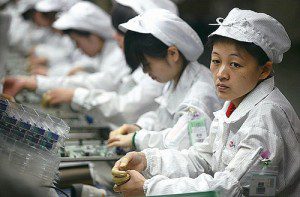By Lois Becket – alternet.org
Breaking down what we know about Foxconn, the massive factory in China where workers manufacture popular products like iPhones and iPads.
An investigative series by the New York Times and a performance piece by Mike Daisey featured on This American Life have put the spotlight on Foxconn, the Taiwanese company whose massive Chinese factories manufacture some of the world’s most popular consumer electronics.
As well as working with companies like Dell, Motorola, Nokia and Hewlett-Packard, Foxconn assembles popular Apple products like the iPhone and iPad.
Here’s a quick look at what we know about Foxconn. (The company disputes workers’ accounts of abusive conditions. In a 2010 company report, Foxconn said it promotes “employee respect, an atmosphere of trust, and personal dignity.”)
Working for Foxconn
1.2 million: number of workers employed by Foxconn in China, according to the New York Times.
40: Estimated percent of the world’s consumer electronics manufactured by Foxconn.
7: seconds it takes Foxconn’s workers to complete a single step of their work, according to a survey cited by the New York Times.
12: Hours in a typical work shift, according to interviews with Foxconn employees.
83.2: Average hours of overtime worked each month, according to a 2010 survey of Foxconn employee.
13: age of a Foxconn employee Mike Daisey interviewed outside the gates of a Foxconn plant in Shenzhen.
91: cases of underage labor found by Apple’s audits of its suppliers in 2010, the year Daisey visited China.
3,000: number of workers Foxconn could hire overnight, according to Apple’s former worldwide supply demand manager.
10-20: percent estimated monthly turnover in Foxconn’s workforce.
$7,500: amount founder Terry Gou used to start the anchor company of Foxconn Technology Group in 1974, according to the company website.
$5.7 billion: Terry Gou’s estimated net worth as of March 2011.
Living Conditions
230,000: number of workers at “Foxconn City” in Shenzhen, according to the New York Times.
13: tons of rice prepared each day at the central kitchen at Foxconn City.
$0.65: meal allowance for dinner at the Foxconn City canteen in 2010.
2: number of free swimming pools there, according to The Telegraph, which noted that the pools “are said to be quite dirty.”
70,000: number of workers at Foxconn’s Chengdu plant who live in company dorms, according to the New York Times.
20: number of employees sometimes packed into a three-room apartment.
200: Reported number of police officers who responded to a Foxconn dormitory riot.
Deaths
17: Number of reported suicides of Foxconn workers in China between 2007 and February 2011, according to Wired. Eleven workers died after jumping off buildings in the Foxconn Campus in Shenzhen, which were then draped with preventive netting. (Wired noted that the rate actually seems to be below China’s national averages.)
70: number of psychiatrists employed by Foxconn to prevent suicides, according to a 2010 announcement by CEO Terry Gou.
100: Estimated number of employees at a Foxconn factory in Wuhan who stood on the roof of a factory building this month to protest working conditions and wages. Several threatened to commit suicide, according to the New York Times.
$450: monthly salary a worker involved in that protest said employees had been promised for moving from the Foxconn campus in Shenzhen to one in Wuhan.
34: continuous hours a Foxconn employee worked in 2010 before he collapsed and died, according to media reports.
About the Author
Lois Becket has reported on changes in the news industry for the Nieman Journalism Lab. She was a 2010 Village Voice Media Fellow at the SF Weekly. She has written for the Times of India, the Accra Daily Mail, and the Reading Eagle, among others. She graduated from Harvard College with a degree in Social Studies.

If you've found value in our articles, we invite you to support the release of our brand-new book, "Gratitude Practices for Kids: A Practical Guide for Adults to Instill a Spirit of Appreciation and Positivity in the Next Generation."
"Gratitude Practices for Kids" brings together over 25 innovative and accessible practices designed to enhance gratitude in everyday life. This comprehensive guide is backed by 17 scientific studies, ensuring each concept is grounded in research, underscoring our commitment to nurturing growth, emotional intelligence, and positive interactions between adults and children.
We encourage you to opt for the paperback version to celebrate this new release. Dive into its fresh pages away from digital distractions, allowing you to immerse yourself in the transformative practices it offers.
Over recent years, Wake Up World has faced significant online censorship, which has impacted our financial ability to operate. Moving into book publishing represents a strategic step to secure the ongoing funds needed to continue our mission. By purchasing Gratitude for Kids, you help us keep our content free and accessible to everyone, avoiding needing a paywall. With over 8,500 articles published in the last 13 years, we remain dedicated to keeping our valuable content open to all.








